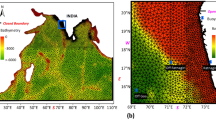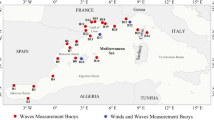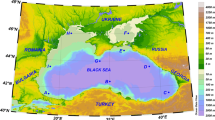Abstract
Spatial and temporal variations of significant wave height (H m0) and wind speed (WS) at selected locations over the Black Sea are studied based on 31-year long-term SWAN simulations forced with Climate Forecast System Reanalysis dataset. The objective was to investigate whether or not there is a possible increase in wind and wave conditions along the Black Sea shelves. Wind and wave parameters are obtained at 33 locations enclosing the Black Sea coast line from SWAN simulations and annual mean and maximum H m0 and WS values as the climatological variables are computed for these locations. Using these data, long-term trends and their significance at these locations are investigated based on Mann–Kendall trend test. To quantify the trends, Sen’s slope estimator and least square linear regression (the slope of the linear best-fit curve) are used. Variation of monthly mean H m0 and WS values at these locations are also discussed. Besides, decadal variations of these four climatological variables at 33 locations are studied. The results show that higher wind speeds and wind wave heights are monitored in the winter season in all locations, while during the summer months, there is a significant drop in both H m0 and WS. In the western Black Sea, average H m0 is highest (about 1.02 m) at locations 23 and 25. During the period of 1979 and 2009, it is determined that mean WS has a weak significant increasing trend (maximum 1.29 cm/s/year) along the north-eastern coasts of Turkey and the Crimean peninsula, while there is no statistically significant H m0 trend in the Black Sea except at location 11, offshore Sochi in the north-eastern part of the Black Sea. A weak decreasing trend (maximum 0.24 cm/year) in mean H m0 is seen along the north-western coasts of Turkey, while maximum H m0 and WS show no statistically significant increasing or decreasing trend except location 2, which has a weak significant increasing trend for maximum WS. All the trends at other locations for four variables are statistically insignificant, and they have no trend. The most significant difference is observed in maximum WS as 6.14 m/s in different decades in the north-western part of the Black Sea. The difference in the decades is very low in mean H m0 at all locations. Mean wind and wave conditions at all locations have almost negligible difference, whereas decadal variations of maximum H m0 and WS show high differences. This may be probably due to storms and cyclones conditions.










Similar content being viewed by others
References
Akpınar A, van Vledder GPh, Kömürcü Mİ, Özger M (2012) Evaluation of the numerical wave model (SWAN) for wave simulation in the Black Sea. Cont Shelf Res 50–51:80–99
Akpınar A, Bekiroğlu S, van Vledder GPh, Bingölbali B (2015) Temporal and spatial analysis of wave energy potential during south western coasts of the Black Sea. TUBITAK Project No. 214M436
Anoop TR, Kumar VS, Shanas PR, Glejin J (2015) Surface wave climatology and its variability in the North Indian Ocean based on ERA-Interim reanalysis. J Atmos Ocean Technol 32(7):1372–1385
Bacon S, Carter DJT (1990) Wave climate changes in the North Atlantic and North Sea. Int J Climatol 11:45–558
Battjes JA, Janssen JPFM (1978) Energy loss and set-up due to breaking of randomwaves. In: Proceedings of 16th international conference on coastal engineering, ASCE. pp 569–587
Batu M (2008) Considering the condition of Karaburun sea with wave energy spectrum. Master thesis, Yildiz Technical University, Istanbul, Turkey (in Turkish)
Booij N, Holthuijsen LH, Ris RC (1999) A third-generation wave model for coastal regions. Model description and validation. J Geophys Res 104(C4):7649–7666
Caires S, Sterl A, Bidlot J-R, Graham N, Swail V (2004) Intercomparison of different wind-wave reanalysis. J Climate 17(10):1893–1913
Çevik E, Yüksel Y, Yalçiner AC, Güler I, Ari A (2006) Determining shoreline change and sedimentation problem, case study: Karaburun, TÜBİTAK, İÇTAG 1845(1031008) (in Turkish)
Cox A, Swail V (2001) A global wave hindcast over the period 1958–1997: validation and climate assessment. J Geophys Res 106(C2):2313–2329
Dietrich JC, Zijlema M, Allier P-E, Holthuijsen LH, Booij N, Meixner JD, Proft JK, Dawson CN, Bender CJ, Naimaster A, Smith JM, Westerink JJ (2012) Limiters for spectral propagation velocities in SWAN. Ocean Model 70:85–102
Douglas EM, Vogel RM, Kroll CN (2000) Trends in floods and low flows in the United States: impact of spatial correlation. J Hydrol 240:90–105
Dragani WC, Martin PB, Simionato CG, Campos MI (2010) Are wind wave heights increasing in south-eastern south American continental shelf between 32°S and 40°S? Cont Shelf Res 30:481–490
Eldeberky Y (1996) Nonlinear transformation of wave spectra in the nearshore zone, Ph.D. thesis, Delft University of Technology, The Netherlands
GEBCO (2014) British Oceanographic Data Centre, Centenary Edition of the GEBCO Digital Atlas [CD-ROM]. Published on behalf of the Intergovernmental Oceanographic Commission and the International Hydrographic Organization, Liverpool
Gorrell L, Raubenheimer B, Elgar S, Guza RT (2011) SWAN predictions of waves observed in shallow water onshore of complex bathymetry. Coast Eng 58:510–516
Gower JFR (2002) Temperature, wind and wave climatologies, and trends from marine meteorological buoys in the northeast Pacific. J Climate 15:3709–3717
Grevemeyer I, Herber R, Essen HH (2000) Microseismological evidence for a changing wave climate in the northeast Atlantic Ocean. Nature 408:349–352
Gulev SK, Grigorieva V (2004) Last century changes in ocean wind wave height from global visual wave data. Geophys Res Lett 31:L24302
Gulev SK, Hasse L (1999) Changes of wind waves in the North Atlantic over the last 30 years. Int J Climatol 19(10):1091–1117
Hasselmann S, Hasselmann K, Allender JH, Barnett TP (1985) Computations and parameterizations of the linear energy transfer in a gravity wave spectrum, part II: parameterizations of the nonlinear transfer for application in wave models. J Phys Oceanogr 15(11):1378–1391
Hithin NK, Kumar VS, Shanas PR (2015) Trends of wave height and period in the Central Arabian Sea from 1996 to 2012: a study based on satellite altimeter data. Ocean Eng 108:416–425
Janssen PAEM (1989) Wave induced stress and the drag of air flow over sea waves. J Phys Oceanogr 19:745–754
Janssen PAEM (1991) Quasi-linear theory of wind-wave generation applied to wave forecasting. J Phys Oceanogr 21:1631–1642
Kendall MG (1975) Rank correlation methods. Griffin, London
Komen GJ, Cavaleri L, Donelan M, Hasselmann K, Hasselmann S, Janssen PAEM (1994) Dynamics and modelling of ocean waves. Cambridge University Press, Cambridge, pp 554
Krestenitis YN, Androulidakis Y, Kombiadou K (2012) Storm surge modelling in the Black Sea. In: Proceeding of protection and restoration of the environment XI, At Thessaloniki, Greece, pp 786–795
Kumar VS, Anoop TR (2015) Spatial and temporal variations of wave height in shelf seas around India. Nat Hazards 78(3):1693–1706
Kumar VS, Sajiv C (2010) Variations in long term wind speed during different decades in Arabian Sea and Bay of Bengal. J Earth Syst Sci 119:639–653
Kumar D, Sannasiraj SA, Sundar V, Polnikov VG (2013) Wind wave characteristics and climate variability in the Indian Ocean region using altimeter data. Mar Geod 36:303–313
Mann HB (1945) Nonparametric tests against trend. Econometrica 13:245–259
Mendez FJ, Menendez M, Luceno A, Losada IJ (2006) Estimation of the long- term variability of extreme significant wave height using a time dependent POT model. J Geophys Res 111:C07024
Menendez M, Mendez FJ, Losada IJ, Gram NE (2008) Variability of extreme wave heights in the north east Pacific Ocean based on buoy measurements. Geophys Res Lett 35:L22607
Özhan E, Abdalla S (1998) Wind-wave climate of the Black Sea and the Turkish coast (NATO TU-WAVES project). Proceedings of 5th international workshop on wave hindcasting and forecasting, Jan 27–30, Melbourne, pp 71–82
Özsoy E, Ünlüata Ü (1997) Oceanography of the Black Sea: a review of some recent results. Earth-Sci Rev 42:231–272
Partal T, Kahya E (2006) Trend analysis in Turkish precipitation data. Hydrol Process 20:2011–2026
Polonsky AB, Fomin VV, Garmashov AV (2011) Characteristics of wind waves of the Black Sea. Rep Natl Acad Sci Ukr 8:108–112 (Russian)
Reguero BG, Méndez FJ, Losada IJ (2013) Variability of multivariate wave climate in Latin America and the Caribbean. Global Planet Change 100:70–84
Ris RC, Holthuijsen LH, Booij N (1999) A third-generation wave model for coastal regions: 2, verification. J Geophys Res 104(C4):7667–7681
Rogers WE, Hwang PA, Wang DW (2003) Investigation of wave growth and decay in the SWAN model: three regional-scale applications. J Phys Oceanogr 33:366–389
Rusu E, Pilar P, Guedes Soares C (2008) Evaluation of the wave conditions in Madeira Archipelago with spectral models. Ocean Eng 35:1357–1371
Saha S, Moorthi S, Pan H-L, Wu X, Wang J, Nadigai S, Tripp P, Kistler R, Woollen J, Behringer D, Liu H, Stokes D, Grumbine R, Gayno G, Wang J, Hou Y-T, Chuang H-Y, Juang H-MH, Sela J, Iredell M, Treadon R, Kleist D, van Delst P, Keyser D, Derber J, Ek M, Meng J, Wei H, Yang R, Lord S, van den Dool H, Kumar A, Wang W, Long C, Chelliah M, Xue Y, Huang B, Schemm J-K, Ebisuzaki W, Lin R, Xie P, Chen M, Zhou S, Higgins W, Zou C-Z, Liu Q, Chen Y, Han Y, Cucurull L, Reynolds RW, Rutledge G, Goldberg G (2010) The NCEP climate forecast system reanalysis. B Am Meteorol Soc 91:1015–1057
Şahin C (2007) Parametric wind wave modelling; Western Black Sea case study. Master thesis, Yildiz Technical University, Istanbul, Turkey (in Turkish)
Sajiv PC, Kumar VS, Glejin J, Dora GU, Vinayaraj P (2012) Interannual and seasonal variations in nearshore wave characteristics off Honnavar, west coast of India. Curr Sci 103:286–292
Sen PK (1968) Estimates of the regression coefficient based on Kendall’s tau. J Am Stat Assoc 63:1379–1389
Shanas PR, Kumar VS (2015) Trends in surface wind speed and significant wave height as revealed by ERA-Interim wind wave hindcast in the Central Bay of Bengal. Int J Climatol 35:2654–2663
Soares CG (1986) Assessment of the uncertainty in visual observations of wave height. Ocean Eng 13:37–56
Sterl A, Komen GJ, Cotton P (1998) Fifteen years of global wave hindcasts using winds from ECMR weather forecast reanalysis: validating the reanalyzed winds and assessing the wave climate. J Geophys Res 103(C3):5477–5492
Swain J (1997) Simulation of wave climate for the Arabian Sea and Bay of Bengal, PhD thesis, Naval Physical and Oceanographic Laboratory, Kochi
Tabari H, Marofi S (2011) Changes of pan evaporation in the west of Iran. Water Resourc Manage 25:97–111
Tabari H, Marofi S, Aeini A, Hosseinzadeh Talaee P, Mohammadi K (2011) Trend analysis of reference evapotranspiration in the western half of Iran. Agric For Meteorol 151(2):128–136
Valchev NN, Trifonova EV, Andreeva NK (2012) Past and recent trends in the western Black Sea storminess. Nat Hazards Earth Syst Sci 12:961–977
Van Ledden M, Vaughn G, Lansen J, Wiersma F, Amsterdam M (2009) Extreme wave event along the Guyana coastline in October 2005. Cont Shelf Res 29:352–361
Van Vledder GPh, Akpınar A (2015) Wave model predictions in the Black Sea: sensitivity to wind fields. Appl Ocean Res 53:161–178
Vanem E, Walker S-E (2013) Identifying trends in the ocean wave climate by time series analyses of significant wave height data. Ocean Eng 61:148–160
Wang A, Swail V (2001) Changes of extreme wave heights in Northern Hemisphere Oceans and related atmospheric circulation regimes. J Clim 14(10):2204–2221
Wang XL, Swail VR (2002) Trends of Atlantic wave extremes as simulated in a 40-yr wave hindcast using kinematically reanalyzed wind fields. J Clim 15(9):1020–1035
WASA Group (1998) Changing waves and storms in the Northeast Atlantic? Bull Am Meteorol Soc 79:741–760
Wolf J, Woolf DK (2006) Waves and climate change in the north-east Atlantic. Geophys Res Lett 33:L06604
Woolf DK, Challenor PG, Cotton PD (2002) Variability and predictability of the North Atlantic wave climate. J Geophys Res 107(C10):3145
Yue S, Hashino M (2003) Temperature trends in Japan: 1900–1996. Theor Appl Climatol 75:15–27
Zijlema M (2010) Computation of wind-wave spectra in coastal waters with SWAN on unstructured grids. Coast Eng 57:267–277
Zijlema M, Van Vledder GPh, Holthuijsen LH (2012) Bottom friction and wind drag for wave models. Coast Eng 65:19–26
Acknowledgments
We would like to thank the NCEP CFS team for providing CFSR wind data, the NOAA (General Bathymetric Chart of the Oceans, GEBCO) for the providing the bathymetry data of the Black Sea, the Turkish Ministry of Transport (General Directorate of Railways, Ports and Airports Construction) for the providing the wave measurements at Karaburun, and the NIMRD (Oceanography Department) for the providing the wind and wave measurements at Gloria. The authors would like to acknowledge Prof. Dr. Erdal Özhan of the Middle East Technical University, Ankara, Turkey, who was the Director of the NATO TU-WAVES, for providing the buoy data at Gelendzhik, Hopa, and Sinop, and the NATO Science for Stability Program for supporting the NATO TU-WAVES project. We would also like to thank Dr Yalçın Yüksel for his contributions for the measurements at Karaburun and Dr Razvan Mateescu for his helps in providing the measurements at Gloria. This research was supported by the TUBITAK (The Scientific and Technological Research Council of Turkey) within a research project (Project code: 1001- Scientific and Technological Research Projects Funding Program, Project number: 214M436).
Author information
Authors and Affiliations
Corresponding author
Rights and permissions
About this article
Cite this article
Akpınar, A., Bingölbali, B. Long-term variations of wind and wave conditions in the coastal regions of the Black Sea. Nat Hazards 84, 69–92 (2016). https://doi.org/10.1007/s11069-016-2407-9
Received:
Accepted:
Published:
Issue Date:
DOI: https://doi.org/10.1007/s11069-016-2407-9




